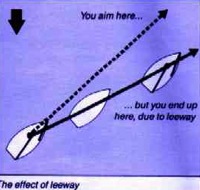Leeway
Definitions
- 1a : off-course lateral movement of a ship when under way
- b : the angle between the heading and the track of an airplane
Description
Leeway is the amount of drift motion to leeward of an object floating in the water caused by the component of the wind vector that is perpendicular to the object’s forward motion. The National Search and Rescue Supplement to the International Aeronautical and Maritime Search and Rescue Manual defines leeway as "the movement of a search object through water caused by winds blowing against exposed surfaces". However, the resultant total motion of an object is made up of the leeway drift and the movement of the upper layer of the ocean caused by the surface currents, tidal currents and ocean currents. Objects with a greater exposure to each element will experience more leeway drift and overall movement through the water than ones with less exposure.
A navigator or pilot on a vessel must adjust the ordered course to compensate for the leeway drift and more important set and drift, an all encompassing term for drift that includes the steering error of the vessel. Failure to make these adjustments during a voyage will yield poor navigational results. Bowditch's American Practical Navigator (1995) offers a comprehensive free guide to navigation principles.
An object can be classified as either an active object like a ship navigating through a waterway or a passive object like a liferaft, drifting debris, or a person in the water (PIW). A passive object will experience the greatest leeway drift and it is this drift that is of utmost importance to those involved in search and rescue (SAR) upon inland waterways and open oceans.
Leeway is used as a synonym for the ability to exercise freedom, flexibility or latitude in [decision]-making processes.[1]
